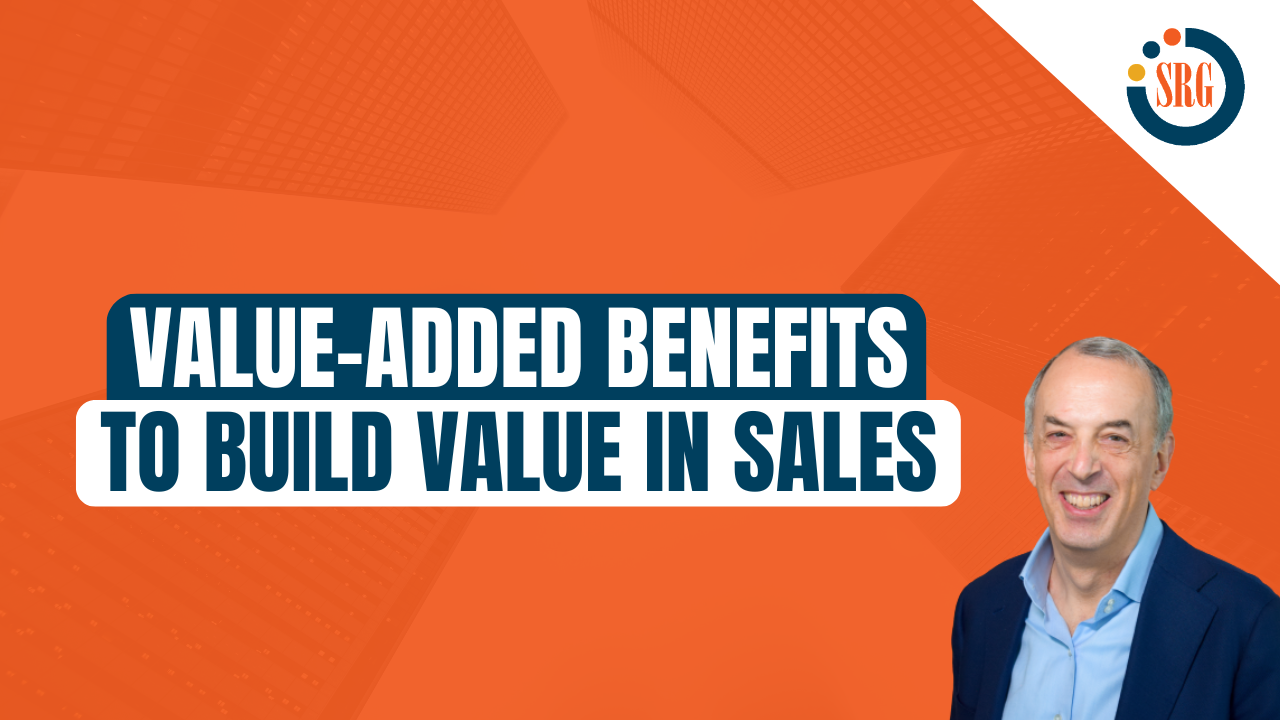How to Build Value in Sales with Value-Added Benefits


Think of the last time you won a close, competitive sales opportunity. What tipped the scales in your favor?
In sales situations where it’s difficult to differentiate your solution from the competition’s, you often win by offering your buyer extra services or Value-Added Benefits.
Chances are you're already providing your buyers Value-Added Benefits, but you're not getting credit for them.
What Are Value-Added Benefits?
Value-Added Benefits (VABs) are the extra services above what you provide with your primary solution, which are provided without additional cost to the buyer. Providing Value-Added Benefits as part of your solution can make the difference between winning and losing in a competitive situation. They can also help reinforce with the customer on why buying your solution is a good decision and make for an effective sales presentation.
Of course, a Value-Added Benefit must address a specific customer need, otherwise, they won’t value it.
Categories of Value-Added Benefits
When leveraging value-added benefits to gain a competitive edge, it's important to understand that you can offer different categories of value to your customers.
Here are four types of common Value-Added Benefits:
Support Services
Support services are extra services provided by your company, not by you. Support services can include:
- Training Programs: By providing free training programs, whether in-person or online, you can enable customers to make the most out of their purchases.
- Customer Service Hotlines: A 24-hour customer service hotline is a lifeline for your customers when they encounter issues, have questions, or need assistance.
- Technical Support: Offering dedicated technical support, whether through phone, email, or live chat, ensures that customers have access to knowledgeable professionals who can guide them through challenges.
- Online Knowledge Base: Providing a comprehensive online knowledge base or self-help portal equips customers with readily available resources to troubleshoot common issues, access FAQs, and find answers to their questions.
Consulting Services
Consulting services are services that you offer personally such as:
- Strategic Planning: Collaborating with your customers to develop strategic plans aligned with their business objectives can be a powerful value-added benefit.
- Implementation Support: Assisting customers during the implementation phase of your products or services can be a critical value-add. It can involve providing guidance on customization, integration with existing systems, or addressing potential roadblocks.
- Performance Optimization: Offering consulting services to optimize your customers' performance can help them achieve greater efficiency, productivity, and results.
- Training and Development: Sharing your expertise through training programs and workshops can equip your customers with the skills and knowledge to excel in their roles.
Consulting services can require an extensive time commitment on your part, so offer these services only to high-potential accounts.
Personal Services
Exceeding expectations can make a significant difference in sales. By offering these personal touches, you show your customers that you genuinely care about their success and are willing to go the extra mile to support them. Personal services can include:
- Urgent Deliveries: Whether rushing a shipment to ensure a critical deadline is met or delivering a replacement part in person, these actions demonstrate your commitment to the client's success.
- Direct Access and Support: By offering a direct line of communication, you create an environment where customers feel comfortable reaching out whenever they encounter a problem or need assistance.
- Tailored Solutions: By actively listening and customizing your offerings, you demonstrate that you value their requirements and are committed to delivering results.
- Proactive Problem-Solving: By anticipating challenges and providing solutions or preventative measures in advance, you position yourself as a trusted partner who is invested in your customers' long-term success.
Personal services are enhancements that you personally bring to an account, so be careful not to over-commit yourself.
Promotional services
Promotional services encompass a range of offerings, including point-of-purchase materials, advertising support, free samples, job aids or tools, and technical guides. These services enhance the customer experience and contribute to their overall growth and effectiveness. Promotional services can include:
- Point-of-Purchase Materials: Supporting your customers with well-designed and informative point-of-purchase materials can significantly influence their buying decisions and enhance their overall experience.
- Advertising Support: Assisting your customers with advertising support can help them effectively promote their products or services and reach their target audience.
- Free Samples: Offering free samples of your products or services allows customers to experience their value firsthand. This promotional service not only builds trust and confidence but also helps buyers make informed purchase decisions.
- Job Aids or Tools: Providing job aids or tools that simplify tasks or streamline processes for your customers can significantly enhance their efficiency and productivity.
- Technical Guides: Equipping your customers with comprehensive technical guides or manuals ensures they have the information to optimize your products or services.
Remember, any Value-Benefits you offer should relate to the buyer’s needs. Use these categories to trigger your thinking and help you identify which Value-Added Benefits you can provide your customers.
Quantifying Value-Added Benefits
To maximize the competitive advantage that Value-Added Benefits give you, it's important that you quantify their value. Buyers will have a greater appreciation of your total offering when you can quantify the value of Value-Added Benefits.
Not all Value-Added Benefits are easily quantifiable. However, make Value-Added Benefits tangible and memorable by quantifying them whenever possible.
Here's how to quantify Value-Added Benefits:
1. Benefit to the Buyer
Whenever possible, quantify the value the buyer receives. This method provides a concrete figure that highlights the value customers receive. As a backup, if specific buyer benefits are challenging to quantify, you can quantify the cost to your organization of providing the benefit.
For example, "Based on your volume, our free shipping will save you $500 per month."
2. Convert Numbers to Bottom-Line Values
To make the quantification even more impactful, try to express the value-added benefits in dollars rather than percentages or time. While percentages or time frames can be useful, converting them to monetary values helps stakeholders easily grasp the bottom-line impact.
For example, instead of saying, "This could save you up to $8,000 a month," you can say "Your efficiency will increase by up to 10 %."
3. Link Value-Added Benefits Together
Look for as many Value-Added Benefits as possible. When you identify one benefit, it leads to others you might not have considered.
For example, if your product offers increased efficiency, this may lead to reduced labor costs, improved customer satisfaction, or faster time-to-market. This approach not only strengthens your argument but also expands the perceived value of your solution, making it even more enticing for potential buyers.
Here's an example:
"To save you start-up time, which was one of your priorities, I'd like to offer you training and access to our high-priority technical support. If you do have problems, you'll be able to get access to a technician within one hour without any extra charge. Of course, you can always call me directly if you have any urgent issues."
Key Takeaways
Value-Added Benefits are crucial in setting your solution apart in a highly competitive selling situation. By going beyond your core products or services, these additional offerings enhance the customer experience and contribute to their overall success.
By effectively quantifying your Value-Added Benefits, you can enhance buyers' appreciation of your total offering and solidify your position as a trusted partner. Some of the most effective Value-Added Benefits include support services, consulting services, personal services, and promotional services.
💬 Join the Conversation
Have you seen any value-added services used in sales? Share your tips and experiences here.
You may also enjoy these articles on Value-Based Selling
- Asking High IMPACT Questions to Help Buyers Find Value
- Looking for Ways to Sell Value? Start with These 29 Questions
- Sales Performance Indicators: Unit vs Value Win Rate
